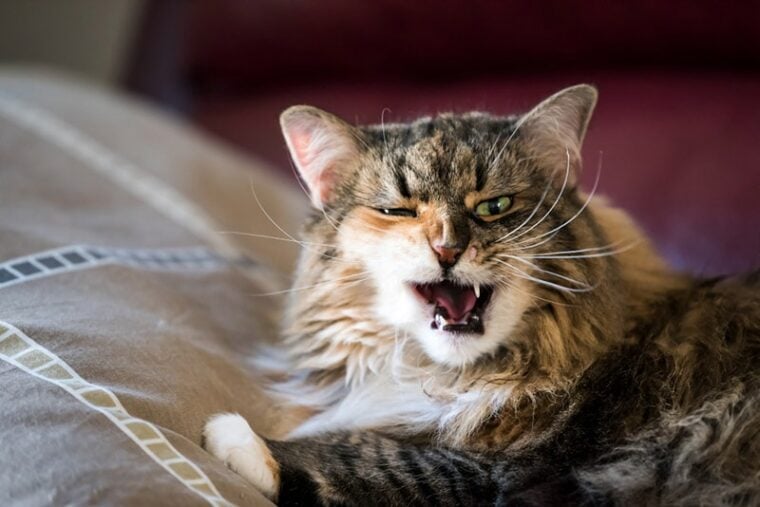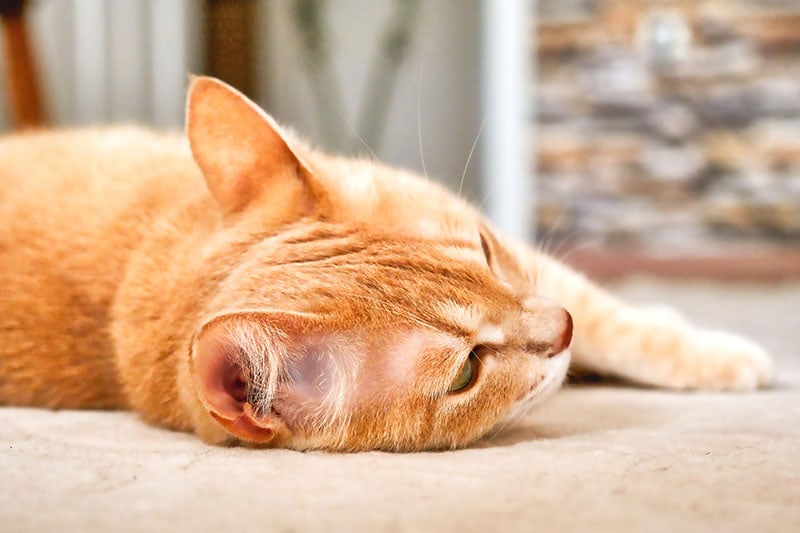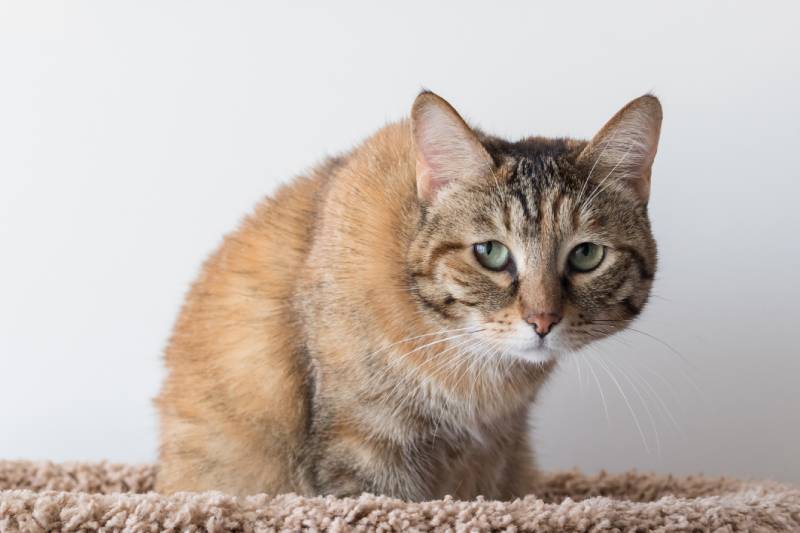
Recognizing early signs of discomfort and pain in your cat is essential in order for you to react in time and ensure that your feline will live a long, comfortable life. However, noticing the signs of pain in cats can often be difficult because cats are excellent at hiding their discomfort and acting like everything is okay.
Therefore, every responsible cat parent needs to learn how to tell if their cat is in pain and if so, how to react accordingly to help the feline cope with it.
How Can You Know That Your Cat Is in Pain?
Cats are extremely good at masking their pain and discomfort, and sometimes the signs are subtle and easy to miss.
This chart summarizes the signs that cats may exhibit when in pain.
| Behavioral signs | Body language signs | Facial expressions |
| Reduced appetite | Bad posture | Closing the eyes |
| No interest in playing, socializing, and usual activities | Crouching | Tension in the mouth, cheeks, and nose |
| Lethargy | Hunching | |
| Hiding | Lowering the head | |
| Increased sensitivity and irritability | Shaking | |
| Poor mood/aggression | Flattened ears | |
| Excessive vocalization | Stiffness | |
| Decreased/increased grooming |
 The 8 Signs That Your Cat Is Experiencing Pain
The 8 Signs That Your Cat Is Experiencing Pain
1. Behavioral Changes
Early indicators of pain in cats are behavioral changes. If your cat is typically social and cuddly, but they suddenly start to be less social and hide more, the reason for that may be pain.
Cats that experience pain may become grumpy and even exhibit sudden aggressive behavior as a way to cope. Pain can make the friendliest cat become nervous and stressed and start to scratch or bite.
If you notice behavioral changes in your feline that may suggest that they are in pain, it’s best to consult your vet.

2. Increased/Decreased Grooming
If your feline has suddenly increased or decreased their grooming habits, that may be a sign of pain and discomfort. Grooming changes are also common when a cat has direct skin wounds, as they frequently lick and bite the painful areas, which may lead to more trauma and cause hair loss, skin infections, and wound formation.
3. Decreased Energy and Activity Levels
It’s natural for cats to become less active as they age. However, if your feline is typically energetic and playful and their behavior drastically changes, an underlying cause like pain might be contributing to these changes.
Most cats that are in pain have low energy and activity levels and may even become lethargic. Some cats may be reluctant to move, have difficulty standing up, and stay away from human companionship.
Since low energy levels can be indicators of pain, it’s best to monitor your feline for such changes in their activity levels and consult your vet if you notice anything out of the ordinary.

4. Changes in Sleep Patterns
Pain in cats can lead to changes in sleep patterns. Some cats may have trouble sleeping due to pain and may have a hard time finding an appropriate position to relax. Other cats may sleep more while experiencing pain, as it can make them feel exhausted and tired throughout the day.
Since quality sleep is necessary for cats to function and develop properly, you should closely monitor any changes in your feline’s sleeping patterns. If you notice that your cat is suddenly sleeping too much or too little, speak with your vet to rule out possible health problems and verify if your furry companion is in pain.
5. Urinating/Defecating Outside the Litterbox
Cats that are in pain may experience various involuntary changes, including the urge to urinate or defecate outside the litterbox. After you teach your cat how and where to go potty, they typically won’t go anywhere else unless there’s a problem.
Although cats may start urinating/defecating outside of the litter box for various reasons, a common reason is pain. For example, it may be difficult to climb into the litter box or get into the squatting position.
Some cats may also experience pain during urination and connect the discomfort with the litter box and therefore, stop using it. Whatever the case is, any urinating/pooping outside the litterbox is a sign that there’s something wrong with your cat and that you should see a vet.

6. Decreased Thirst and Appetite
When cats are feeling distressed or in pain, you’ll likely notice changes in their eating and drinking habits. They may have decreased thirst and appetite and will likely avoid certain foods.
Decreased thirst and appetite are indicators of several severe illnesses in felines, which is why you should immediately take your cat to the vet if their eating patterns have suddenly changed. Waiting too long to contact the vet may have serious consequences for your cat and their health.
7. Abnormal Body Posture and Facial Expressions
A cat in pain will likely exhibit abnormal body posture and facial expression changes. They may always be crouching or hunching. Many will also display grimaces that express the pain that they’re feeling. Cats in pain typically have their eyes closed and their ears flattened out, and they may be shaking, appearing stiff, or lowering their head.
Overall, any changes in the physical appearance of your feline that seem uncomfortable are likely caused by pain, so talk to your vet to see what could be wrong with your furry companion.

8. Excessive Vocalization
If you notice that your cat is meowing, growling, purring, or hissing more than usual, they may be in pain. This is especially noticeable in cats that are usually not that vocal but suddenly start to release all kinds of sounds. Some cats may be excessively vocal when you or a family member approach them, as they may be trying to tell you that they’re feeling pain.
If you notice abnormal vocalization and suspect that your cat may be in pain, it’s best to speak with your veterinarian and get a diagnosis to help your feline.
 What Should You Do If You Think That Your Cat Is in Pain?
What Should You Do If You Think That Your Cat Is in Pain?
If you think that your cat may be in pain, it’s best to consult your veterinarian or take your feline in for a checkup. Regardless of the cause of the problem, never try to treat your cat by yourself, as you could potentially worsen the issue.
Final Thoughts
Although it can be hard to tell if your cat is in pain, it’s not an impossible mission. Remember to closely monitor all aspects of your cat’s life and observe any changes that they may display, from behavioral and posture to habit changes.
If you notice any concerning signs, be sure to check in with your vet, and discuss your feline’s condition to see what’s going on and what you can do to help relieve pain in your furry friend.
Featured Image Credit: Andriy Blokhin, Shutterstock







